I. What are the Fundamentals and Key Terms in RNA Transcription?
If we’re to make an analogy between DNA replication and RNA transcription, they’d basically be cousins! Just like cousins, they’re related but also different, having their own distinct facets and parts that make them each unique as a cellular process.
Similar to DNA replication, it definitely helps to have some basic fundamentals and key terms before tackling the various in depth enzymes and processes of RNA transcription! We’re sensing that you all might be experiencing some deja vu.
If there are some bells ringing in your head or have a nostalgic feeling, you’re on the right track! We’re throwing it back and structuring these RNA transcription articles similar to how we did for the DNA replications: starting off with basic terms then getting into the specific processes and enzymes.
II. Foundations of RNA Transcription
We definitely can’t begin talking about RNA transcription without talking about the central dogma. Let’s quickly review this fundamental molecular biology concept!
A. The Central Dogma: DNA to mRNA to Protein
In its simplest form, the principle states that DNA undergoes transcription to produce RNA, specifically mRNA, which is then translated to produce a protein. Look at the diagram below!

Note that exceptions to the central dogma exist in real life! Take the various retroviruses such as HIV: these viruses will utilize a RNA molecule in order to generate a DNA molecule, which violates the central dogma!
Additionally, it’s important to point out that genes don’t just strictly code for proteins, but can also code for other molecules, like rRNA and tRNA, which have their own specialized functions!B. The Triplet Codon
When the mRNA transcript is read by the ribosome during translation, the transcript is actually read in 3 letter sets called codons! Each 3 letter set can either code for a single amino acid or a stop codon, which means that translation terminates.
Think of the codon kinda like a currency! 3 letters/RNA nucleotides are required to “buy” either an amino acid or stop codon.
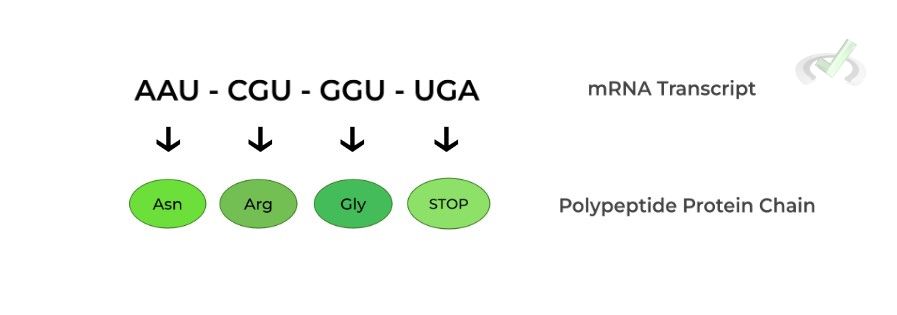
Take a look at this table which lists the various codons and whether they code for an amino acid or a stop codon!
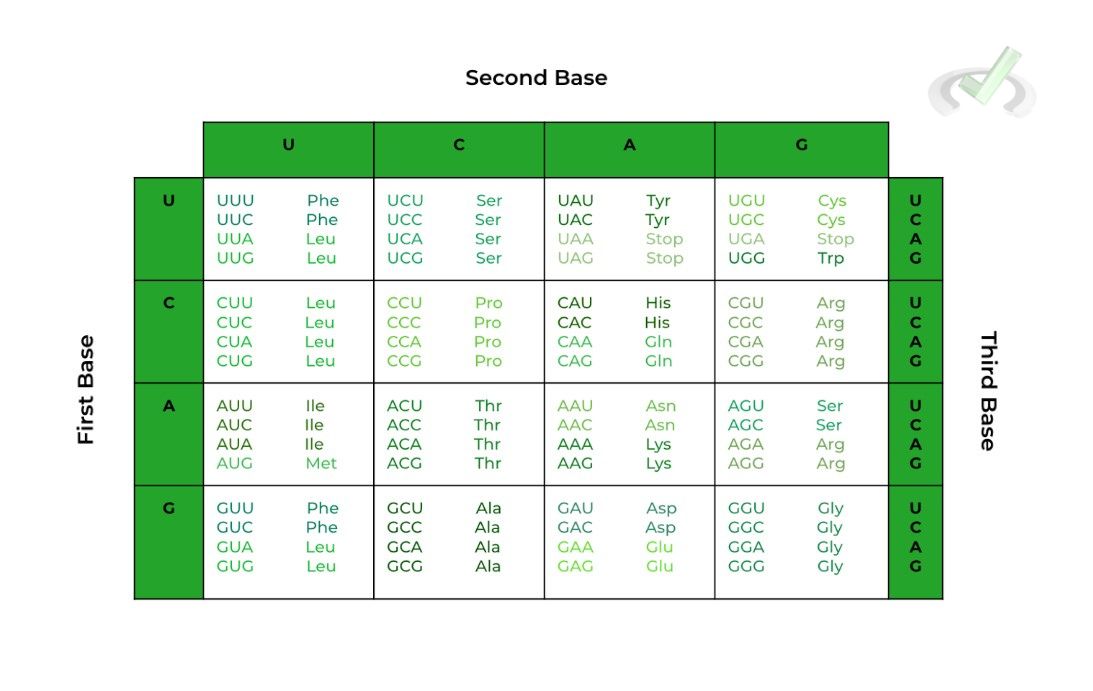
From this table, you can see that one codon codes for ONLY 1 amino acid. For example, GAU codes for aspartate but cannot code for both aspartate and glutamate!
Unambiguous is utilized as a term used to describe the codons only being able to code for one amino acid.
However, this doesn’t mean there is only 1 codon for 1 amino acid: as shown above, there are many codons which code for the same amino acid (i.e. CUU and CUG both code for leucine).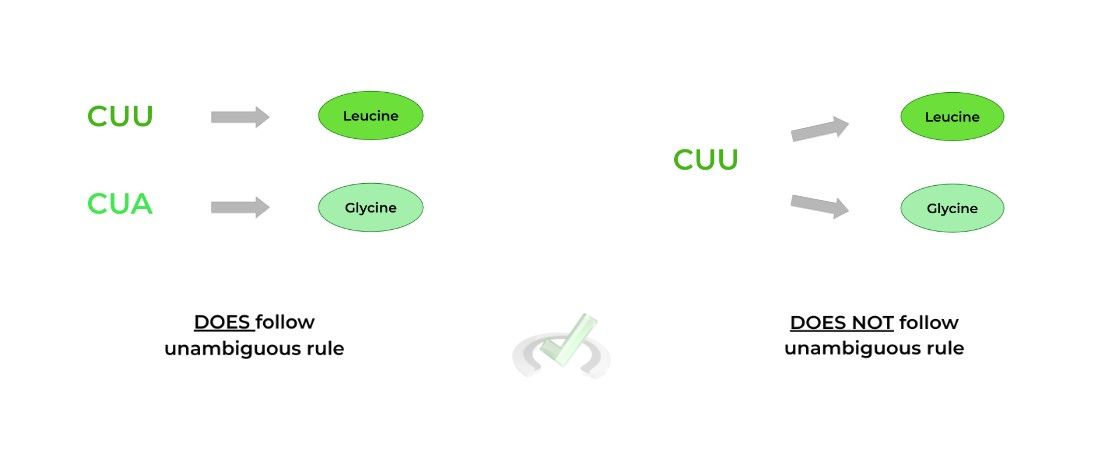
I. Template v.s. Nontemplate Strand
Similar to DNA replication, we can utilize template strands in order to generate the corresponding mRNA transcript!
These strands also have additional tags: the template strand is also called the noncoding strand; the nontemplate strand is also called the coding strand.
The template/noncoding strand will act as a template to produce the mRNA while the coding strand has the nucleotide sequence which actually codes for the protein!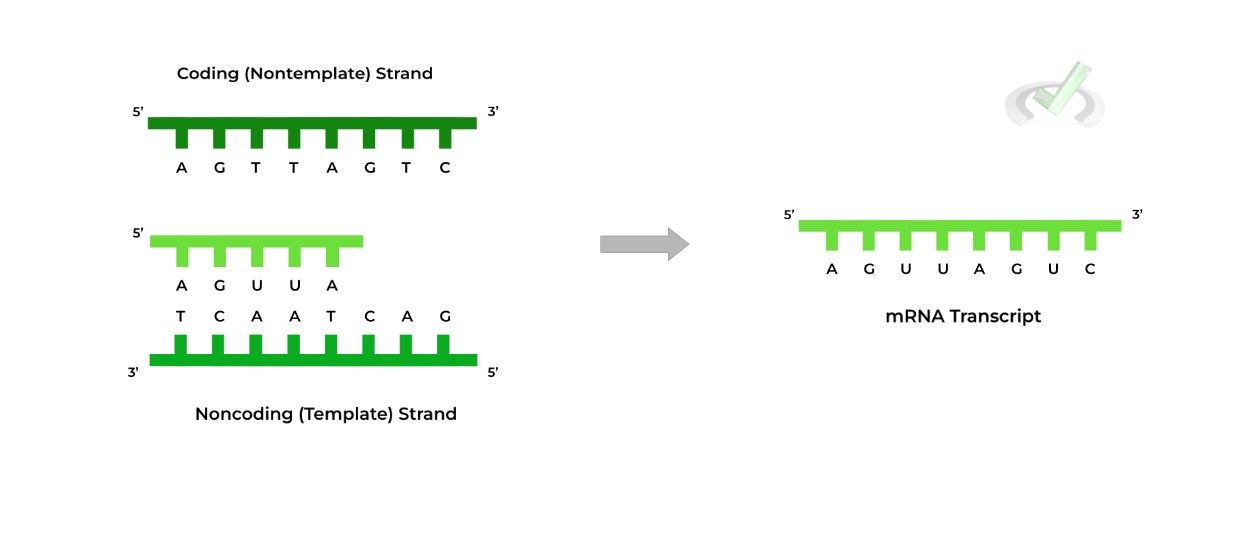
The biggest takeaway from this section is to know that the gene on the coding strand has the exact same sequence as the mRNA transcript, just with the thymine (T) bases replaced with uracil (U) bases in mRNA. Note how the mRNA is also antiparallel to the template strand!
As a tip for memorization, all you have to do is memorize one of the combinations (i.e. non template = coding) and the other pair is essentially the opposite!
II. TATA Box
A great way to think about the TATA box is the RNA transcription equivalent of the origin of replication in DNA replication, as it refers to a sequence just before the coding gene sequence where RNA transcription enzymes organize to initiate transcription!
As the name implies, the sequence is composed of many repeating thymine (T) and adenine (A) nucleotides, as shown in the figure below: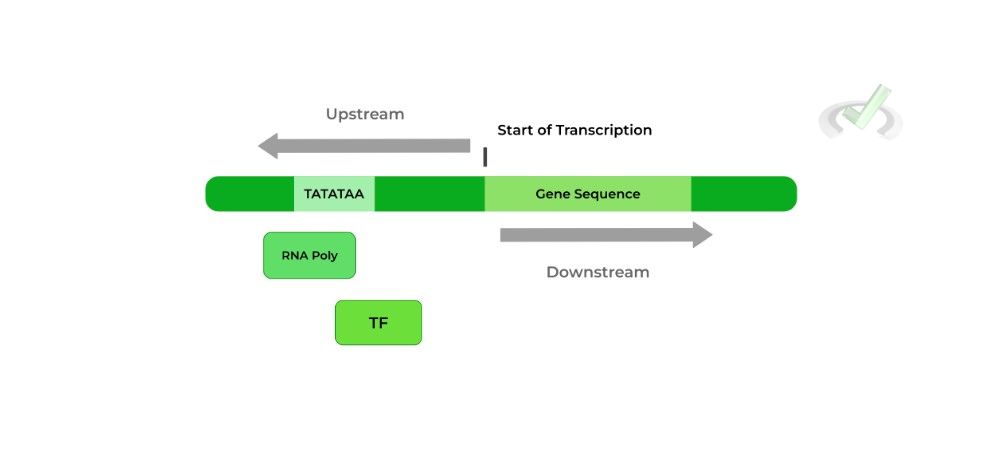
Some good terms to be familiar with are upstream or downstream when describing a gene, as shown above!
Upstream refers to the direction towards the 5’ end of the gene sequence on the coding strand, while downstream refers to the direction towards the 3’ end.
More specifically, it’s used in respect to the start of a transcription site: upstream in this case points to the left while downstream points to the right.
III. Bridge/Overlap
Are there differences between RNA transcription between prokaryotes and eukaryotes just like there are differences in DNA replication? For sure! Let’s review one big difference between prokaryotic and eukaryotic transcription!
I. Monocistronic v.s. Polycistronic Transcription
One major difference is that eukaryotes are strictly monocistronic, meaning that each mRNA transcript only codes for 1 protein! However, prokaryotes have the ability to be polycistronic, where a mRNA transcript can code for more than one protein!
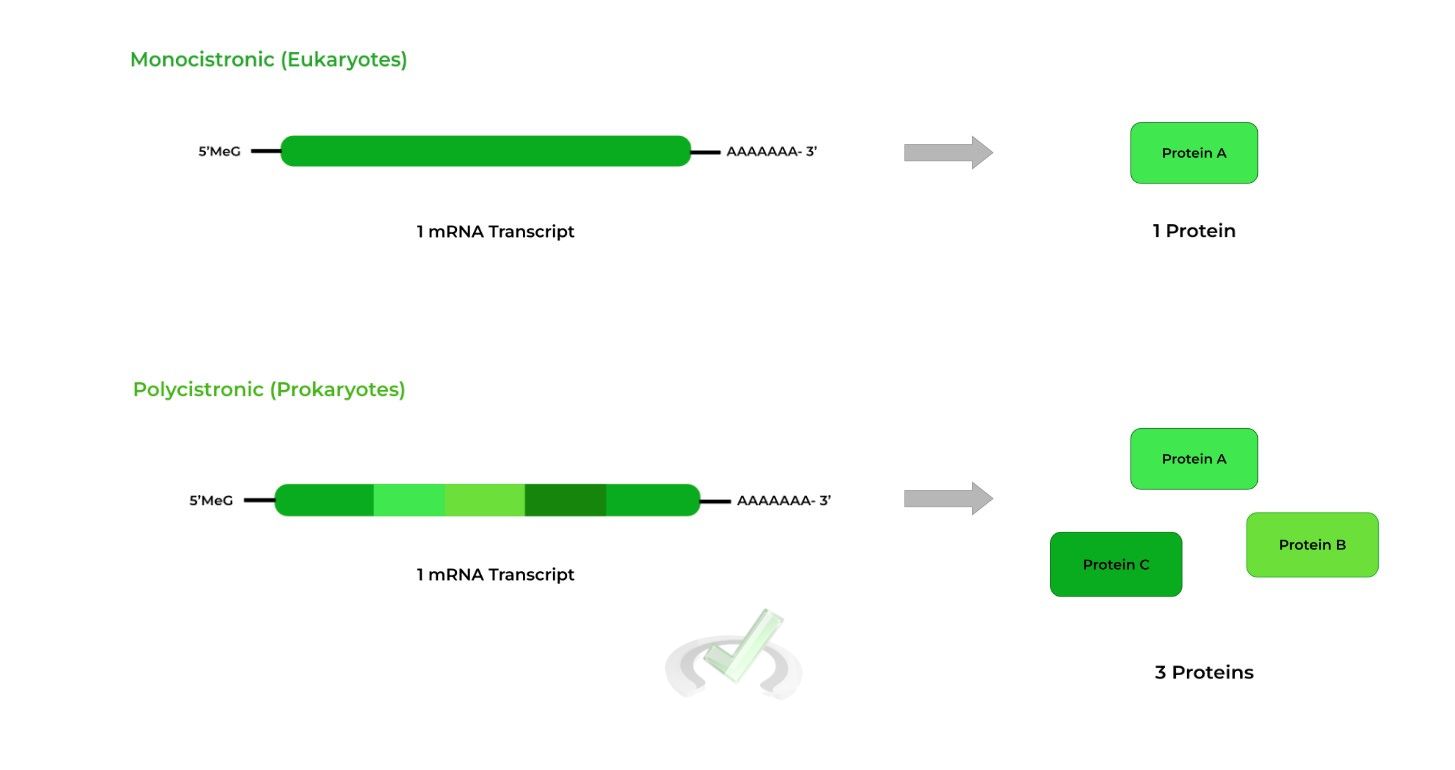
One example of polycistronic genes are in the operon model, where several genes are under the regulation of one promoter region. Although there are 3 genes, they are transcribed as a single mRNA transcript. You’ll learn more about the operon model in other articles!
IV. Wrap Up/Key Terms
Let’s take this time to wrap up & concisely summarize what we covered above in the article!
A. Central Dogma: DNA to mRNA to Protein
The central dogma of molecular biology states that in order for a protein to be produced, DNA must be transcribed into a mRNA transcript, which is then translated into the protein!
B. The Triplet Codon
When being translated in the ribosome, the mRNA molecule is read in 3 nucleotide sets called codons! Each codon codes for either a single amino acid to grow the protein or a stop codon to terminate translation.
Codons are also termed unambiguous, meaning that they only code for a single amino acid; however, many different codons can code for the same amino acids!I. Template v.s. Nontemplate Strand
When learning about the difference between these 2 strands, keep it simple and don’t overthink it! You can really sum it all with the following explanation below:
The template strand, also called the noncoding strand, is used as a template to generate the mRNA transcript.
The nontemplate strand, also called the coding strand, contains the genetic information to code for the protein and will be the exact same sequence as mRNA transcript (with exception of uracil).II. TATA Box
Essentially the RNA transcription equivalent of the origins of replication in DNA replication! Like the origins of replication, the TATA box aids in the organization of RNA enzymes in order to begin RNA transcription.
As indicated by the name, the sequence contains a high amount of repeating thymine (T) and adenine (A) bases.V. Practice
Take a look at these practice questions to see and solidify your understanding!
Sample Practice Question 1
The template (noncoding) strand will be antiparallel to which of the following?
A. Only mRNA transcript
B. Only nontemplate (coding) strand
C. Both the mRNA transcript and nontemplate (coding) strand
D. Neither the mRNA transcript and nontemplate (coding) strand
Ans. C
This question requires you to understand well the concept of antiparallel DNA structure and a little bit of spatial reasoning. The mRNA will be antiparallel because it is using the template strand as a template – hence, it will always be complementary.
Likewise, the nontemplate (coding) strand should also be antiparallel because it’s the complementary strand to the template strand, even without RNA transcription taking place.
Sample Practice Question 2
Given a mRNA transcript, AAU - UGC - AGA, which codes for the structural protein domain of a cellular protein. When the protein is transcribed, do you expect this structural segment to be located within the protein core or the protein surface? (Follow the table given earlier in the article!)
Ans. Protein Surface
After following the table in the article, the codons will code for asparagine, cysteine, and arginine, all of which are either polar or charged amino acids.
As such, this protein segment should be located on the protein surface as it forms favorable dipole-dipole interactions with the polar cytosol!



 To help you achieve your goal MCAT score, we take turns hosting these
To help you achieve your goal MCAT score, we take turns hosting these 
























